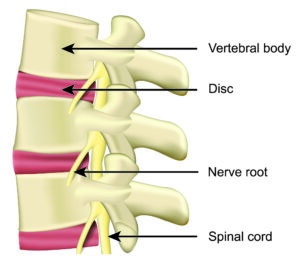Dr. Kaiwan M. Randeria
Dr. Kaiwan M. Randeria is an Orthopedic Surgeon, holding a Fellowship in Joint Replacement Surgery. He aims to increase awareness about bone health, which has been adversely affected in keeping with today’s unhealthy lifestyle and nutritional issues. [Connect with him at: drkaiwan94@gmail.com ]
 We have all had the occasional back-ache. While sometimes, it disappears by itself, other times it may persist. Let us try to explore the most common problems, simplified for you.
We have all had the occasional back-ache. While sometimes, it disappears by itself, other times it may persist. Let us try to explore the most common problems, simplified for you.
We start with understanding the anatomy of the spine and the causes for lower back-ache. The spine’s anatomy comprises 33 vertebrae connected by means of joints, forming a column. Between each vertebra lies a disc made of cartilage, acting as a cushion / support. The spinal cord lies in the central canal of these vertebrae and gives off branches (nerve roots) that emerge from the sides in between the vertebrae. This spinal column is supported by various ligaments and encased in the muscles of the back.
Causes Of Lower Back Pain: can be classified under categories like Mechanical, Degenerative, Inflammatory and Infectious.
MECHANICAL: Due to injury to the spine, intervertebral discs, or soft tissues. This can include Fractures (Spondylolisthesis) where an upper vertebra slips forward over the lower one; Lumbago or a muscle-strain due to a sporting activity, wrong posture or lifting heavy weights; Disc Herniation, where an inter-vertebral disc protrudes out of the disc space causing compression of the surrounding nerve roots; or Pregnancy where the growing foetus exerts pressure on the vertebrae and the joint between the spine and the pelvis.
DEGENERATIVE: This includes Osteoarthritis, Spinal Canal Stenosis (compression of the spinal cord due to degenerative changes in the tissues encasing the spinal cord) and Degenerative Disc Disease where the intervertebral disc is degenerated and protrudes out of the column, thus compressing the nerves.
Osteoporotic compressive fractures are also a degenerative process in which the weakened vertebrae can fracture (sometimes even without any trauma i.e., injury). This may lead to compression of the spinal cord. Sometimes in metastases to spine, (spread of tumor from other organs to the vertebra), the patient may have dull aching pain with lesions leading to fractures in the vertebra.

INFLAMMATORY: This is caused primarily due to inflammatory disorders in the joints and ligaments of the spine and is termed as ankylosing spondylitis
INFECTIOUS: Infections of the spine, discs or muscular / soft tissue abscesses
Low backache can manifest in an array of symptoms, which may be overlapping. It can be localized to the lower back and aggravated during movements (facet joint arthritis). In case of acute, sudden onset muscle spasm, it can be painful on certain movements, localized to the muscle and very discomforting. When any nerve compression is associated with a disc prolapse (i.e., herniated disc) or canal stenosis, the pain starts from the lower back and usually radiates down one or both of the legs. There could also be a tingling sensation in the limbs too incase of nerve compressions, vascular pathologies or other neurological problems. When there is an infection of the spine or discs, there will be fever and accompanying weight loss. For inflammatory disorders, the pain is usually severe in the morning on waking up and reduces after activity.
Managing Your Lower Back Pain:
Causes of backache are manifold and should not be self-diagnosed. Always see a specialist for the correct diagnosis and treatment as it involves a thorough clinical examination and related imaging for the same. The treatment is then dictated based on the underlying cause. However, here are some basic back care tips that can help avoid the common causes of back strain:
- Back Care Exercises: Stretching in the morning, doing yoga and proper warm up before any sporting exercises or gymming
- Correct Posture: Adopt correct posture while sitting at work cannot be emphasized enough.
- Maintaining Healthy Body Mass Index (BMI): Overweight people have a higher tendency for back injuries and disc prolapse, hence it’s advisable to maintain an optimal BMI.
- Correct Technique While Gymming / Sports: It’s crucial to practice the correct form i.e., the specific way of performing the movement, especially while lifting heavy weights.
- Adequate Calcium, Vitamin B12, Vitamin D In Diet: There is a high tendency of osteoporosis especially in middle-aged women and the elderly, leading to a weakened vertebral column and high susceptibility for fractures. Having a healthy diet comprising milk products, eggs, fish, leafy greens, soya bean, etc. helps. In case the deficiency has been detected via blood tests, supplementation as advised by the orthopaedician proves useful.
Disclaimer: The contents of this article should not be considered as medical advice. Kindly visit your orthopaedician for any related treatment.
- જેજે હોસ્પિટલના પારસી વોર્ડમાં નવરોઝની ઉજવણી - 5 April2025
- ઝોરોસ્ટ્રિયન વિમેન્સ એસોસિએશન ઓફ સુરત દ્વારા પાણી બચાવો પર્ફોર્મન્સ - 5 April2025
- આવાં યઝદના પરબની ઉજવણી - 5 April2025
